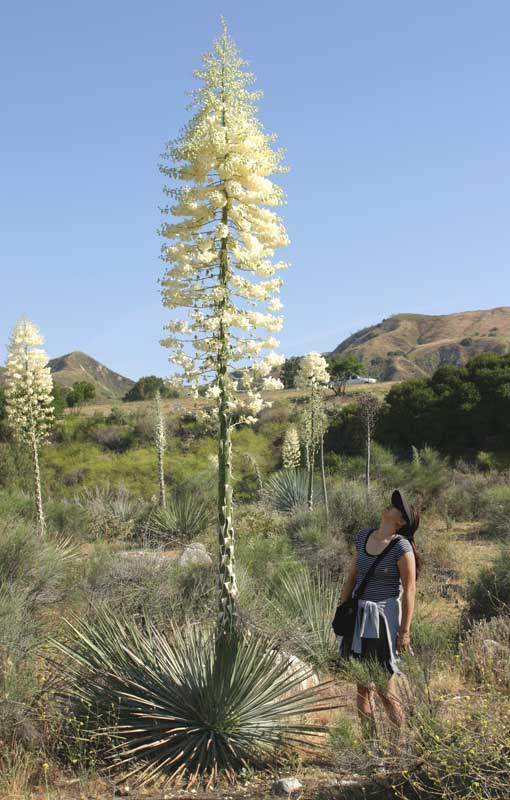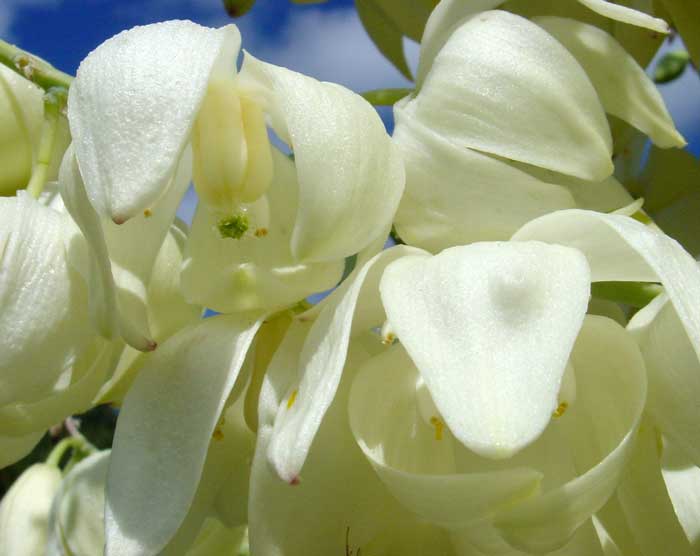Ethnobotany of southern California native plants:
Our Lord’s Candle (Yucca whipplei)

photo credit: Vgrubsky CC BY-SA 3.0, via Wikimedia Commons
The dramatic flower spike of Our Lord’s Candle.

Our Lord’s Candle growing near Palm Springs
Our Lord’s Candle (Yucca whipplei)
Our Lord’s Candle is a flowering yucca also known as ‘Spanish bayonet’. This gorgeous desert plant is native to southern California and Baja, Mexico. The name ‘Our Lord’s Candle’ is a reference to the huge, flame-like spike of flowers which emerges from the cluster of rigid leaves. The name ‘Spanish bayonet’ is derived from the sharp, rigid leaf tips that could pierce through flesh, much like a sword.
This dramatic yucca species produces a cluster of long, stiff leaves that terminate in a sharp point. The edges of the leaf exhibit a fine serrated edge.
The large flower spike (seen in photo) emerges quickly and eventually reaches up to 12 feet into the sky. This inflorescence displays hundreds of purple-white bell-shaped flowers. These flowers bear winged, capsule fruits that split up and release seeds.
Historical use of Our Lord’s Candle
This yucca was commonly used by the Native Americans of southern California. The plant provided rugged material for clothing and construction. It also provided food in many forms.
The Cahuilla and Kumeyaay people broke up the stiff leaves into fibers. The fibers were then reconstructed to make rope, cloth and sandals. The Chumash people, who lived out on the Channel Islands, used this fiber material for fishing line.
These yucca leaves were also split and used to bundle up supplies. Baskets, house frames and foraging material could be packaged with the split leaves.
Eating Our Lord’s Candle
Most parts of this plant were eaten. As the plant matured throughout the year, different sections of the plant became available for consumption.
The Kumeyaay boiled the young flowers and ate them. However, due to the bitter taste of the flowers, the Kumeyaay had to boil and purge the cooking water multiple times to eliminate the sharp taste.
The stalk of the flower spike was also eaten. Just prior to blossoming, the flower stalk was cut and roasted overnight to soften it up. The cut stalk was also boiled like squash.
Fruits could be eaten raw, roasted or pulverized with a metate. The seeds were also consumed, either whole or pounded into a seed paste.
The Kawaiisu enjoyed eating the apical meristem, or the heart of this yucca plant. This plant material could be removed with a shaft of juniper branch. The yucca heart was then roasted on an open fire pit for a long time.

credit: Consultaplantas, CC BY-SA 4.0 via Wikimedia Commons
The bitter-tasting, white, bell-shaped flowers.
Please return to our main Ethnobotany of southern California page.
On our main ethnobotany page, we present a clickable list of the southern California native plants that became a part of the culture of Native Americans and early European settlers. These plants were used for medicine, food, shelter, drink, tools and art.
Warning: The information about plants on this website is intended for general educational purposes only. The author of this website accepts no responsibility for problems arising from the user’s misidentification, misuse, or use of plants. Please read the full TERMS associated with this website.
